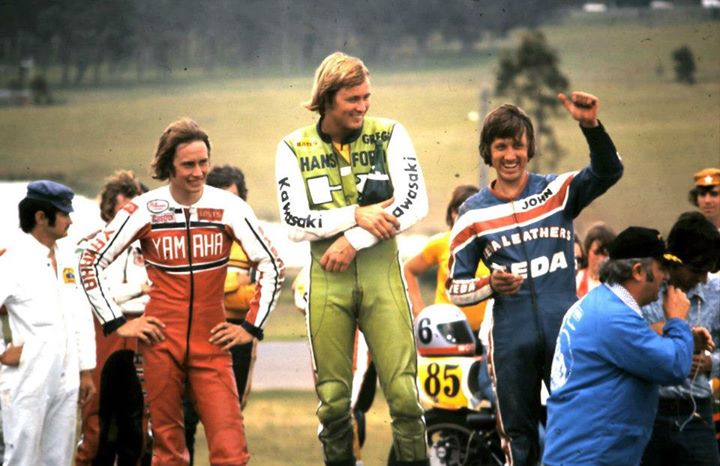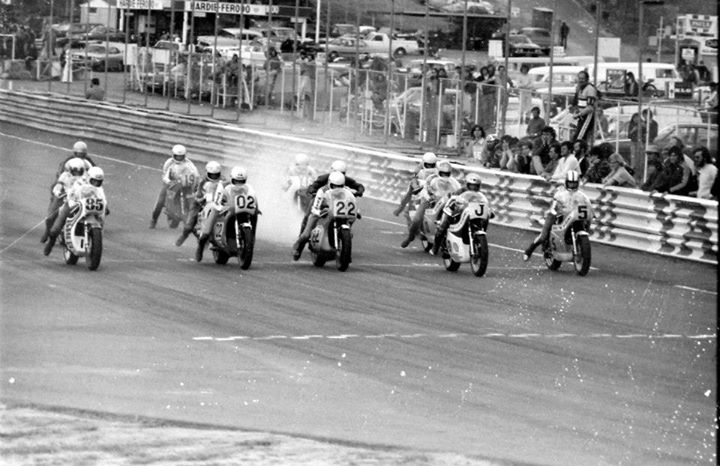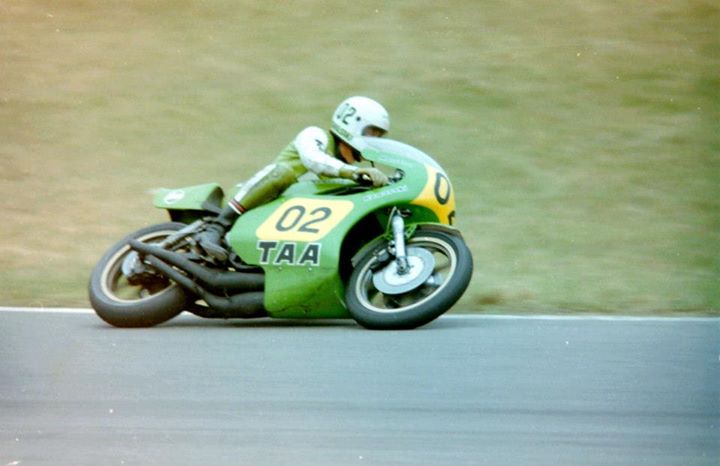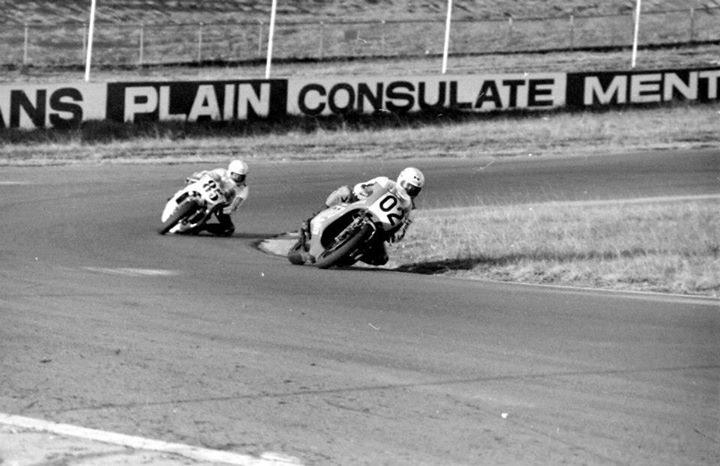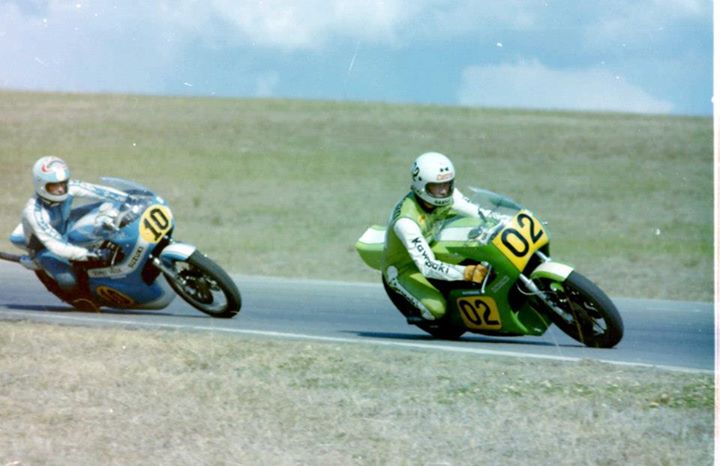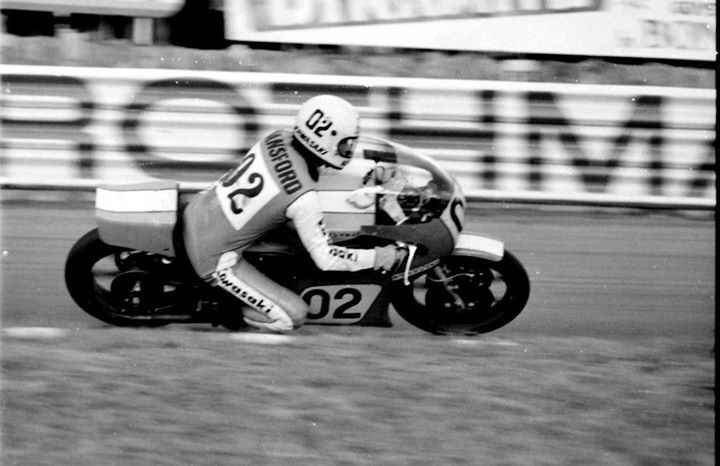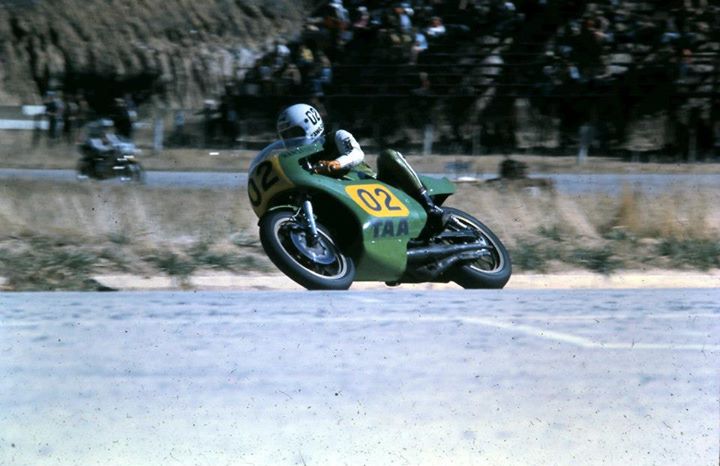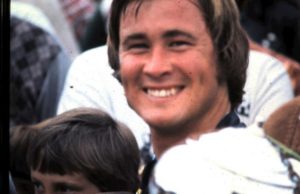
Gregory John Hansford (born April 5th 1952, died March 5th 1995)
By Phil Hall
This week marks the 19th anniversary of Australia’s favourite motorcycle road racer, Gregg “Harry”: Hansford.
Gregg Hansford raced motorcycles for a living. By the late 1970′s he was the first, and, at that time, the only road racer in Australia, to be a full-time professional racer. He started his career racing mini bikes and dirt bikes, and by his early 20′s he had attracted the attention of some serious sponsors within the sport.
Queensland motorcycle dealer, Annand and Thompson, bought a brand new Yamaha TZ700 for Gregg to race and it was on this bike, in 1974 that the 1973 500cc and Unlimited Champion staged what many regard to be the most thrilling race ever seen at the Bathurst Easter Bike Carnival. Arch-rival and Sydney “boy wonder”, Warren Willing, was similarly mounted on a bike sponsored by Sydney dealer Adams and Sons and the rivalry between these two young stars was intense.
These two riders staged an epic duel in the Unlimited Grand Prix, chopping and changing the lead throughout the whole 20 lap race, barely inches apart for the whole race distance. In the end, the race went to Willing by the slimmest of margins, but it was enough to let everyone know that the tall, beach-blonde, Queenslander had “arrived”. Gregg and Warren both travelled to Daytona that year as well, and while Warren’s ride fell through, Gregg rode, against the likes of multi-World Champion, Giacomo Agostini, and many notables in the sport overseas sat up and took notice as well.
Hansford and Willing continued their bitter rivalry right throughout the 1974 season in Australia, and, early in 1975, Gregg got his big break. As is often the case, it came through someone else’s misfortune. Team Kawasaki Australia, the first truly professional motorcycle racing team in Australia, was running two riders on factory-supported, but locally-developed Kawasaki H2R triples (750cc). Their #1 rider was multiple Australian Champion and multiple Bathurst winner, Ron Toombs. He was backed up by another up-and-coming rider, the curly-haired Murray Sayle. These days Murray is still with Kawasaki and heads up their entire racing division.
In March of 1975, Toombsie suffered serious injuries to his arm in an accident at Sydney’s Amaroo Park Raceway. With the metal plate inserted into his left elbow after the crash, and retirement after a distinguished career being called early, Doyle took the opportunity to offer the gig to Hansford, who, of course, accepted.
Toombs subsequently announced his retirement from the sport, a resolve that lasted until he was tempted out of it by a chance to ride a brand new TZ350 at Bathurst at Easter time in 1979. Despite having nothing left to prove to the world, Ron got on and, in practice, and on a bike wearing slicks, the first time in his whole career that he had done so, he set out to learn the trade all over again. Despite protestations to my brother and I, who spoke to him in the pits, that he was “only out there to have some fun”, two laps into the session he was belting down into Murrays Corner at the bottom of Conrod Straight with the rear wheel hopping off the ground under heavy braking.
Bathurst was a funny place. Because the track is so long (6.8km) and covers such a big area, things could happen on one side of the track without you knowing about it on the others side, and so it was that, during the 350cc race, Ron went missing from the groups of bikes heading past my vantage point. Nothing was said over the PA and the race was concluded. As I recall, it was then time for the lunch break and, once Paul and I got back to the pits for lunch, it was evident something was very wrong. Hushed voices, shocked faces and crying. Ron had crashed during the race and he had been pronounced dead at the scene. No wonder we were all shocked. Toombsie was a legend, nobody ever thought of him dying; he would simply always be there.
Ron’s death also highlighted something that only became clear to me a year later when I was commentating at Bathurst and that was that it was a rule of commentary at Bathurst, that no comment be made concerning a death over the PA system until such comment had been cleared by the police and by race officials, and even then, it would be made at the very end of the day’s racing. I saw this policy at work first hand when Queensland’s Rob Moorhouse died at the top of the mountain during the running of the Unlimited Grand Prix in 1980, while I was actually commentating.
So, Gregg became a member of TKA at just the moment when the propaganda machine was kicking into high gear. The “Green Meanies” were on everyone’s lips. TKA deluged the motorcycle press with press releases, photos of Sayle and Hansford posing with their bikes and postcards, give-aways and promotional objects of all kinds were churned out by the TKA Publicity Department, most featuring either Gregg or Murray or both of the riders, doing towering wheelstands down the main straight at Oran Park. Professional motorcycle racing had arrived in Australia.
Hansford and Sayle repaid the faith that Kawasaki and Doyle had placed in them by also winning the 1975 Castrol Six Hour Production Bike Race at Amaroo Park on, appropriately, a Kawasaki Z1.
Gregg kicked off 1976 by winning the Unlimited TT at Laverton Air Force Base just outside Melbourne, giving the brand new, water-cooled KR750 its most important win to date. That day Gregg defeated a star-studded field that included the best of the local talent plus American star, Pat Hennen. Another trip to Daytona ensued in which Gregg finished 4th, the first Kawasaki home, easily accounting for the Team Hansen Kawasakis, the American version of TKA. The American Kawasaki officials were stunned that Doyle had extracted both Yamaha-like power and reliability from the fast-but-fragile KR.
1976 belonged to Hansford and, despite being the “2nd pick in the draft”, there was no doubt, almost from day one who the team’s leader and # 1 rider was. Gregg was the #1 pin-up boy of racing, along with Warren Willing. He had the stature, the blond hair, the boyish charm and he was unbeatable on a bike. He was, in short, a promoter’s dream.
And it was the revelation that TKA’s tuning department (Neville Doyle) was doing it better than any other local Kawasaki racing effort that caused the factory to place even more faith and valuable development resources into its hands. Of course, the bikes went even better, were more reliable and won more races.
Lest it be thought that Gregg and TKA confined themselves to just the “big” meeting, such was not the case. If there was a meeting on somewhere on any given weekend, you could almost be sure that they would be there. I saw them race at Hume Weir, a tiny little track just outside of Albury where grass grew in the cracks in the bitumen along the main straight.
He was master of Lakeside, his “home” track; a tight and unforgiving wrecker of bikes and riders. Seeing him wrestle a “hinge in the middle” Z1 around the 1.1kms of Amaroo Park was also a treat. And seeing him and Murray pull monster wheelstands on the short straight after Stop Corner was astounding as well.
As an amateur photographer, following the circus and making ends meet by selling my work, I took some time before I dared approach the TKA pit. After all, they were the kings of the heap. But, once I did so, I found what everybody who dealt with Gregg found. That, despite the clamour, the sometimes panic and the intensity of race day, Gregg always had time to stop and talk and give you the benefit of his valuable time. To me he seemed very shy, almost unbelieving of the success that had come his way, pinching himself from time to time just to check and see if it was real.
The world stage beckoned and we were not surprised when in 1978, TKA took off for Europe to provide Gregg with the support he needed for a full-scale assault on the World 250cc and 350cc championships, as well as selected Formula 750 races with the now utterly reliable KR750.
Facing Gregg was a horde of Yamaha “works” and privateer rivals, as the 250 and 350 scene there was absolutely white hot. But his most serious rival was going to be the South African, Kork Ballington, riding similar Kawasaki KR’s but supported by the British arm of Kawasaki’s world-wide racing effort.
Placed side by side, Hansford was a better rider in almost every department, and, by everyone’s expectation, it should have been a “no contest”. But it wasn’t, as there was a problem that no amount of riding skill, engineering expertise and cunning could overcome. Kork was a tiny man, just a little over 5 foot tall, and light to boot. Gregg was a monster, well over 6 feet tall and markedly heavier than not only Kork, but nearly all his fellow competitors. Wrapping his huge frame around the tiny 250′s and 350′s meant that there were bits of him hanging out everywhere, while Kork could “tuck in” almost completely and so achieve not only a better power-to-weight ratio, but also vastly better aerodynamics.
In 1978 Gregg finished 2nd in the 250 World Championship and 3rd in the 350. In 1979 he duplicated this result again. In 1980 he finished 2nd in the prestigious Suzuka 8 Hour Race, riding with Eddie Lawson, and then, in 1981, at Spa, in Belgium, he suffered a serious fall that caused horrific injuries to his knee. Not long afterwards, faced with a long lay-off and rehabilitation, Gregg “eased out” of motorcycle road racing. With 10 victories at the Grand prix level, Hansford still ranks 3rd on the list of overall Grand Prix wins for an Australian.
During this time, Gregg had also made many F750 appearances and competed in New Zealand in the Marlboro Series, a summer series for F750 bikes that allowed many riders from the northern hemisphere to escape the northern winter and race in the sunshine. Amongst the riders to regularly make the trip “down under” for this very prestigious series was a 15 year old, freckle-faced kid named Randy Mamola, riding a TA125 Yamaha grand prix bike. Gregg competed the Marlboro Series twice on the KR750 and it was at one of these races that he scored his most amazing victories.
Having crashed his 750 in the first race of the two-leg meeting at one of the NZ tracks in the 1978-79 series, Gregg fronted the starter for the final race of the day on his 250!! Officials and spectators were stunned, but, as the race progressed, Hansford not only kept the 750′s in sight, but, on the tight track, began to pick up places until he was in the lead. Then disaster seemed to strike. Watching from the pit wall, Neville Doyle noticed that Gregg’s front tyre was going flat. Now, it was a “given” back then that NOBODY braked harder or later than Gregg, but, despite this handicap affecting the part of his riding that he relied on most, he negotiated the rest of the race without incident and, riding a superbly tactical race, brought the bike home, flat front and all, in FIRST place.
Gregg took time off to develop his motorcycle dealership in an outer Brisbane suburb and seemed to have settled well into a premature, but well-deserved, retirement. But the competitive spirit burnt very brightly within Gregory John and nobody was surprised when he announced that he was going car racing.
His first big win was in the 1984 Oran Park 250, followed by wins in the 1988 Sandown 500 and the 1994 Bathurst 12 Hour. Such performances gained him drives in both V8 Supercars and Supertourers, with highlights being 1st in the 1993 Bathurst 1000, 3rd in the 1994 Bathurst 1000 and 3rd in the 1994 Sandown 500 partnered with Larry Perkins.
Hansford’s 1993 Bathurst win gave him the unique distinction of winning a race at the Mount Panorama Circuit in both motorcycle and car racing.
Like people who lived through the era, if you ask anyone where they were when they heard of President Kennedy’s assassination, they will be able to tell you. And so it is that I can remember exactly the circumstances on the awful day when my brother rang me and asked, “Have you heard about Harry? I replied that I hadn’t and I listened, stunned, as he told me that “Harry” had died in a piddling little two-litre sedan car race at Phillip Island. While competing in a Supertourer race, Hansford’s Ford Mondeo slid off the track at Turn 1 and hit a tyre wall at high speed. The car bounced back onto the track where he was hit by another car at over 200 km/h. The car had slewed around after the initial impact with the tyre wall and came out onto the track with the left hand side of the car facing the oncoming traffic. As the car was left hand drive, the impact on the driver’s side door was always going to be catastrophic. Hansford died moments after the impact and was pronounced dead at the scene.
Thus passed the legend, Gregg Hansford, into the history books. For Gregg was much more than just a sublimely talented rider. He was more than just the first professional rider to grace a sport that now has many who claim that title. He was more than just the rider who carved out, more than any other, a pathway that the Gardners, the Doohans and the Stoners were later to follow. No, above all this, Gregory John Hansgord was a true gentleman and one of the loveliest persons that you could ever hope to meet.
Despite his absolute superstar status at the top of his career, he remained, humble, approachable and self-effacing. The world of motorcycle racing will never see his like again. RIP, Gregg Hansford.
